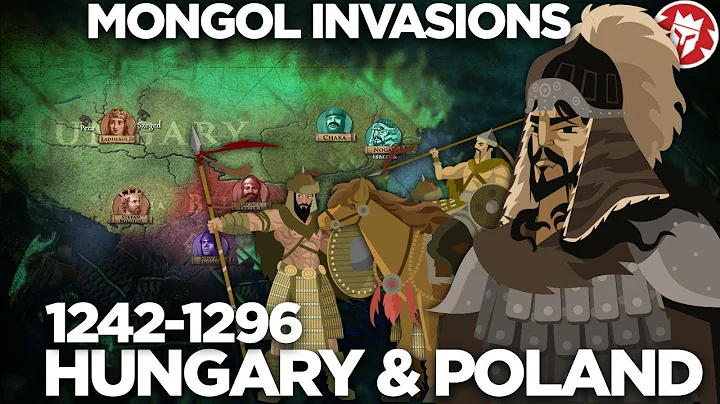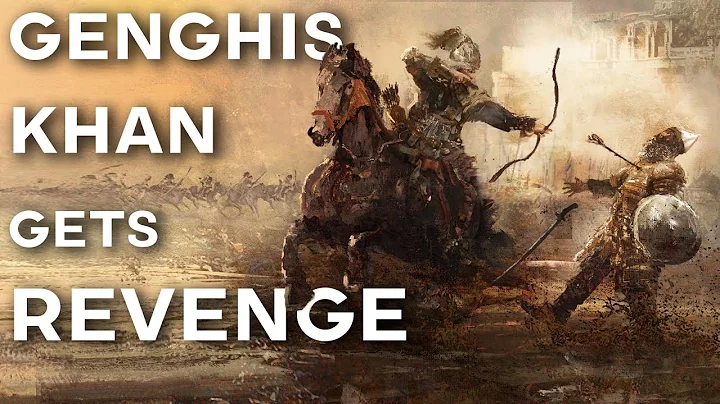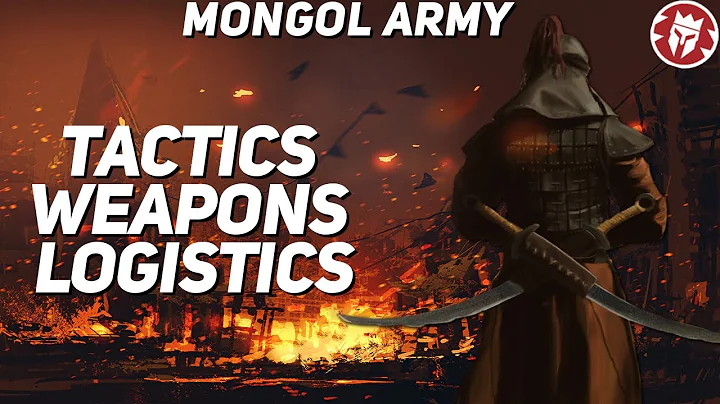Foreword
In the 13th century, nomadic warriors gradually emerged on the Mongolian grasslands. After the rise, the Mongols quickly conquered the Mongolian grasslands with their powerful cavalry combat power, and eventually unified the Eurasian continent. established the most powerful and powerful country in human history, namely the Mongol Empire . Throughout human history, the myths created by the Mongol Empire are the most numerous in human history. But what is curious is that it was such a powerful empire that spanned the Eurasian continent that eventually came to ruin in just a few decades. How powerful was the Mongol Empire? What was the final reason for its demise?

▲ Mongolian Legion
The powerful Mongol Empire
1, opening up territory
From 1209 AD to 1218 AD, in just nine years, the Mongolian Empire quickly conquered the southwest of Mongolian grassland by applying its powerful cavalry combat capabilities. Gaochang Uighur and Xiliao . At the same time, starting in 1211, the Mongols attacked the Jin Kingdom many times and defeated the Jin Kingdom's army several times. In 1214 AD, the Mongolian army actually reached Zhongdu, the capital of the Jin Kingdom, with only tens of thousands of cavalry. , ultimately forcing the powerful Jin Kingdom to seek peace from the Mongols by ceding territory and paying compensation.
1218, King Khorezm assassinated Mongolian missions and business groups. Genghis Khan sent an envoy to negotiate, but the envoy was killed by King Khorezm. As a last resort, Genghis Khan led the Mongolian cavalry to start the first Western expedition. levy. In this Western Expedition , the Mongolian army destroyed the Khwarezm Kingdom in just two years, making the Khwarezm country destroyed. In 1235, in order to further expand the territory of Mongolian rule, the Mongolian army once again marched westward. This western expedition was led by Batu, the grandson of Genghis Khan.

▲Cavalry
In this Western Expedition, the Mongolian army reached what is now Moscow and other places in just 5 years, and captured many cities such as Moscow and Kiev. At this point, the Mongolian army relied on its powerful cavalry combat capabilities to break through the borders of Asia and penetrate deep into Europe. In 1241 AD, the Mongolian army commander Batu led the Mongolian army to attack countries such as Poland and Hungary , and captured Poland and Hungary in a very short period of time. After
Poland and Hungary were captured, the Mongolian army continued to attack and continued to capture Slovakia and Czech other European countries, and finally arrived near Vienna . According to historical records, Vienna was the westernmost place reached by the Mongolian army during its second western expedition. The Mongolian army made three expeditions to the west. The third expedition was led by Mongol 's younger brother Hulagu . During this western expedition, the Mongolian army occupied a large area of Arabia. The army penetrated into the hinterland of Syria and conquered Middle East is a large land. At this point, the Mongols established a powerful empire spanning Eurasia.

▲Cold weapon war
2, Crazy ambition
In the feudal era, wars were usually based on cold weapons. On the battlefield of cold weapons, no country could expand like the Mongolian Empire for more than 50 consecutive years. The Mongolian army originated from the grasslands. Generations of nomadic life in the grasslands have made every Mongolian brave and good at fighting. Mongolian warriors have lived on horseback since childhood. After Genghis Khan unified the Mongolian grasslands, he quickly turned the tribes of the Mongolian grasslands into powerful war machines.
In order to make it easier to launch wars with foreign countries, Genghis Khan established a unique thousand-household system . Through this system, Genghis Khan included the people of the Mongolian grasslands into a thousand households, and abolished the traditional management system based on clans and tribal alliances. , forming a strict hierarchical affiliation. Under this strict hierarchical affiliation, every Mongolian tribe and every Mongolian soldier became a cruel weapon for Genghis Khan to launch wars. To a certain extent, during Genghis Khan's rule of the Mongolian tribes, all the people in the Mongolian grassland were soldiers. . This shows how ambitious the Mongol Empire under Genghis Khan was. It seems that this empire was born to conquer the world from the day it was born.

▲The impact of cavalry
3, the warlike blood
People of the Mongolian Empire have lived on horseback since childhood. Their ancestors have been good at horseback riding and archery. Their hunting life for generations has developed their martial spirit, and because of Characteristics of diet, Mongolian body is strong . Looking at the whole world, Mongolians seem to be born warriors. Their nomadic life and eating habits from generation to generation have created their martial spirit and strong body. In addition, the unique harsh climate of the Mongolian grasslands has also tempered them for generations. The tough character of the Mongolian people makes the Mongolian grassland warriors extremely brave when they go to the battlefield. There is warlike blood in the genes of Mongolian warriors from generation to generation.

▲ Mongolian warriors
4, born for belief
The Mongolian Empire has believed in shamans for generations. In the mind of every Mongolian warrior, Immortality is the eternal god and the highest level god. After Genghis Khan succeeded to the throne, Genghis Khan As the representatives of the Immortal God, the Mongolian warriors believed that Genghis Khan was blessed by the gods, and all decisions and actions made by Genghis Khan must be supported. To some extent, during the Genghis Khan era, Genghis Khan had become a god among the Mongols.
Mongolians have lived on the grasslands for generations. They have been in close contact with nature for a long time. Over time, their spirits are filled with worship of gods and nature. In the hearts of every Mongolian warrior, there is a devout worship of gods. After Genghis Khan unified the Mongolian grasslands, the worship of gods in the hearts of Mongolian warriors for a long time was pinned on Genghis Khan, and finally broke out in the form of war.

▲ Mongolian army camp
The destruction of the empire
1, the fatal injury of the cavalry
During the entire process of the Mongol Empire's foreign conquests, the cavalry laid a solid foundation for the Mongol Empire to expand its territory. Even to some extent, Mongolia The reason why the empire was able to achieve such brilliant war achievements was almost entirely due to its powerful cavalry combat effectiveness. In the era of cold weapons, especially in the war of siege of cities and territories, cavalry existed like gods, and their powerful penetration ability was favored by military strategists of all dynasties. But unfortunately, everything has its pros and cons. While the Mongolian cavalry brought powerful war glory to Mongolia, it also paved the way for Mongolia's destruction.

▲ Mongolian life
Cavalry combat usually has such a characteristic, that is, it can easily defeat the enemy, but it cannot defend the captured city. For the cavalry, its biggest advantage on the cold weapon battlefield is surprise. However, when the Mongolian army captured cities one after another, the ensuing problems gradually posed in front of the Mongolian rule. That is, the Mongolian army Although large areas of territory were conquered, these territories were left unmanaged, which caused the Mongolian army to gradually reach its end as it continued to expand. They were able to capture large areas of territory with their strong strength, but they were unable to effectively manage these areas. In the end, when the Mongols established a powerful empire, rebellions continued throughout the empire.
2. Brutal rule
After Genghis Khan unified the tribes of Mongolia, he relied on his powerful military mobilization ability to quickly unite the tribes of the Mongolian grassland into a huge war machine. In the era of Genghis Khan, the tribes of the Mongolian grassland were united and the grassland people The people are united and their fighting spirit is as high as ever. However, after the death of Genghis Khan, the various rulers of various Mongolian tribes all embarked on the path of brutal rule. Since ancient times, the Mongols have been known for their bloody massacres. When Genghis Khan was alive, the leaders of the various Mongolian tribes were afraid of Genghis Khan's rule, and his brutal character was restrained. However, when the Mongolian army lost its commander Genghis Khan, the entire army was filled with dark rule.

▲The war between the two countries
According to historical records, in the late period of the Mongol Empire, many commanders within the Mongolian legions were cruel by nature. They not only liked to massacre cities, but also liked to abuse soldiers.During the period when Genghis Khan ruled the Mongolian Army, although the Mongolian Army was a war machine, it was well organized and well trained. After the death of Genghis Khan, the powerful war machine of the Mongolian Legion instantly lost its ability to control. Bloody incidents within the legion continued, which eventually caused the organization of the Mongolian Legion to collapse. This was one of the important reasons for the collapse of the Mongol Empire.
3. The collision of cultures
To a certain extent, war is a medium for cultural collision. Although the Mongolian warriors unified the territory of Eurasia through war, it is inevitable that during the rule of the Mongol Empire, the unification of Eurasia was only a formal one. There are very deep cultural reasons for this. For thousands of years, there have been huge differences in Eurasian culture. Although the Mongol Empire conquered large areas of Europe with force, tracing its roots, the Mongolian warriors were deeply influenced by Asian culture. When they established a empire across the Eurasian continent In the history of empires, the collision of Eurasian civilizations has kept the national stability of the Mongol Empire in a state of uncertainty. This uncertainty eventually led to the disintegration of the Mongol Empire.

▲The bravery of the Mongolian cavalry
Summary
Throughout human history, the Mongol Empire was a mythical existence. It only took a few decades from the time Genghis Khan unified the various Mongolian tribes to the Mongols establishing a powerful empire across Eurasia. has to admit that this is a myth created by the Mongols and a miracle in the history of human war. But unfortunately, no matter how powerful a country is, it cannot escape the historical law of "the greatest prosperity must inevitably decline." Yes, perhaps the reason why the Mongol Empire fell apart in more than 50 years was precisely because it had grown too fast.
Reference:
"Genghis Khan"
"Mongol Empire"
"The Fall of the Empire"





















